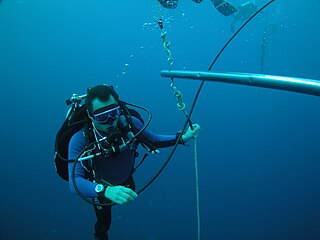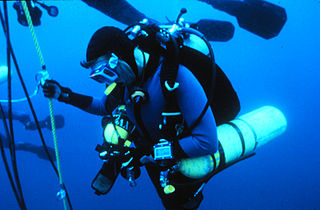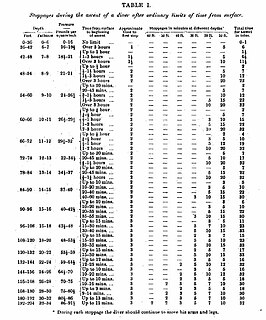Related Research Articles

A dive computer, personal decompression computer or decompression meter is a device used by an underwater diver to measure the elapsed time and depth during a dive and use this data to calculate and display an ascent profile which according to the programmed decompression algorithm, will give a low risk of decompression sickness.
The National Association of Underwater Instructors is a non-profit association of scuba instructors. It primarily serves as a recreational dive certification and membership organization established to provide international diver standards and education programs. The agency was founded in 1960 by Albert Tillman and Neal Hess. NAUI is headquartered in the Tampa, Florida area with dive and member instructors, resorts, stores, service and training centers, located around the world.

Saturation diving is diving for periods long enough to bring all tissues into equilibrium with the partial pressures of the inert components of the breathing gas used. It is a diving technique that reduces the number of decompressions divers working at great depths must undergo by only decompressing divers once at the end, having them remain under pressure for the extent of the diving operation. A diver breathing pressurized gas accumulates dissolved inert gas which can cause decompression sickness if permitted to come out of solution within the body tissues; hence, returning to the surface safely requires lengthy decompression so that the inert gases can be eliminated via the lungs. Once the dissolved gases in a diver's tissues reach the saturation point, however, decompression time does not increase with further exposure, as no more inert gas is accumulated.
Decompression has several meanings, some of which are covered by several articles:
The Varying Permeability Model, Variable Permeability Model or VPM is an algorithm that is used to calculate the decompression stops needed for ambient pressure dive profiles using specified breathing gases. It was developed by D.E. Yount and others for use in professional diving and recreational diving. It was developed to model laboratory observations of bubble formation and growth in both inanimate and in vivo systems exposed to pressure. In 1986, this model was applied by researchers at the University of Hawaii to calculate diving decompression tables.
In diving and decompression, the oxygen window is the difference between the partial pressure of oxygen (PO2) in arterial blood and the PO2 in body tissues. It is caused by metabolic consumption of oxygen.
The Bühlmann decompression algorithm is a mathematical model (algorithm) of the way in which inert gases enter and leave the human body as the ambient pressure changes. Versions are used to create Bühlmann decompression tables and in personal dive computers to compute no-decompression limits and decompression schedules for dives in real-time. These decompression tables allow divers to plan the depth and duration for dives and the required decompression stops.

A dive profile is a description of a diver's pressure exposure over time. It may be as simple as just a depth and time pair, as in: "sixty for twenty," or as complex as a second by second graphical representation of depth and time recorded by a personal dive computer. Several common types of dive profile are specifically named, and these may be characteristic of the purpose of the dive. For example, a working dive at a limited location will often follow a constant depth (square) profile, and a recreational dive is likely to follow a multilevel profile, as the divers start deep and work their way up a reef to get the most out of the available breathing gas. The names are usually descriptive of the graphic appearance.
Ratio decompression is a technique for calculating decompression schedules for scuba divers engaged in deep diving without using dive tables, decompression software or a dive computer. It is generally taught as part of the "DIR" philosophy of diving promoted by organisations such Global Underwater Explorers (GUE) Innerspace Explorers (ISE) and Unified Team Diving (UTD) at the advanced technical diving level. It is designed for decompression diving executed deeper than standard recreational diving depth limits using trimix as a "bottom mix" breathing gas.

In underwater diving, ascending and descending is done using strict protocols to avoid problems caused by the changes in ambient pressure and the hazards of obstacles near the surface such as collision with vessels. Diver certification and accreditation organisations place importance on these protocols early in their diver training programmes. Ascent and descent are historically the times when divers are injured most often when failing to follow appropriate procedure.

The decompression of a diver is the reduction in ambient pressure experienced during ascent from depth. It is also the process of elimination of dissolved inert gases from the diver's body, which occurs during the ascent, largely during pauses in the ascent known as decompression stops, and after surfacing, until the gas concentrations reach equilibrium. Divers breathing gas at ambient pressure need to ascend at a rate determined by their exposure to pressure and the breathing gas in use. A diver who only breathes gas at atmospheric pressure when free-diving or snorkelling will not usually need to decompress, Divers using an atmospheric diving suit do not need to decompress as they are never exposed to high ambient pressure.
This is a glossary of technical terms, jargon, diver slang and acronyms used in underwater diving. The definitions listed are in the context of underwater diving. There may be other meanings in other contexts.

The practice of decompression by divers comprises the planning and monitoring of the profile indicated by the algorithms or tables of the chosen decompression model, to allow asymptomatic and harmless release of excess inert gases dissolved in the tissues as a result of breathing at ambient pressures greater than surface atmospheric pressure, the equipment available and appropriate to the circumstances of the dive, and the procedures authorized for the equipment and profile to be used. There is a large range of options in all of these aspects.

Decompression in the context of diving derives from the reduction in ambient pressure experienced by the diver during the ascent at the end of a dive or hyperbaric exposure and refers to both the reduction in pressure and the process of allowing dissolved inert gases to be eliminated from the tissues during this reduction in pressure.

Decompression theory is the study and modelling of the transfer of the inert gas component of breathing gases from the gas in the lungs to the tissues and back during exposure to variations in ambient pressure. In the case of underwater diving and compressed air work, this mostly involves ambient pressures greater than the local surface pressure, but astronauts, high altitude mountaineers, and travellers in aircraft which are not pressurised to sea level pressure, are generally exposed to ambient pressures less than standard sea level atmospheric pressure. In all cases, the symptoms caused by decompression occur during or within a relatively short period of hours, or occasionally days, after a significant pressure reduction.

A Pyle stop is a type of short, optional deep decompression stop performed by scuba divers at depths well below the first decompression stop mandated by a conventional dissolved phase decompression algorithm, such as the US Navy or Bühlmann decompression algorithms. They were named after Richard Pyle, an American ichthyologist from Hawaii, who found that they prevented his post-dive fatigue symptoms after deep dives to collect fish specimens.

Haldane's decompression model is a mathematical model for decompression to sea level atmospheric pressure of divers breathing compressed air at ambient pressure that was proposed in 1908 by the Scottish physiologist, John Scott Haldane, who was also famous for intrepid self-experimentation.

There are several categories of decompression equipment used to help divers decompress, which is the process required to allow divers to return to the surface safely after spending time underwater at higher ambient pressures.

The thermodynamic model was one of the first decompression models in which decompression is controlled by the volume of gas bubbles coming out of solution. In this model, pain only DCS is modelled by a single tissue which is diffusion-limited for gas uptake and bubble-formation during decompression causes "phase equilibration" of partial pressures between dissolved and free gases. The driving mechanism for gas elimination in this tissue is inherent unsaturation, also called partial pressure vacancy or the oxygen window, where oxygen metabolised is replaced by more soluble carbon dioxide. This model was used to explain the effectiveness of the Torres Straits Island pearl divers empirically developed decompression schedules, which used deeper decompression stops and less overall decompression time than the current naval decompression schedules. This trend to deeper decompression stops has become a feature of more recent decompression models.

The physiology of decompression involves a complex interaction of gas solubility, partial pressures and concentration gradients, diffusion, bulk transport and bubble mechanics in living tissues. Gas is breathed at ambient pressure, and some of this gas dissolves into the blood and other fluids. Inert gas continues to be taken up until the gas dissolved in the tissues is in a state of equilibrium with the gas in the lungs,, or the ambient pressure is reduced until the inert gases dissolved in the tissues are at a higher concentration than the equilibrium state, and start diffusing out again.
References
- 1 2 3 Wienke, Bruce R; O’Leary, Timothy R (13 February 2002). "Reduced gradient bubble model: Diving algorithm, basis and comparisons" (PDF). Tampa, Florida: NAUI Technical Diving Operations. pp. 7–12. Retrieved 12 January 2010.
- ↑ Campbell, Ernest S (30 April 2009). "Reduced gradient bubble model". Scubadoc's Diving Medicine. Retrieved 12 January 2010. – Bruce Wienke describes the differences between RGBM and VPM
- ↑ Craciun, Alexandru (19 May 2018). "Decompression Algorithms – RGBM and VPM, a comparative approach" (PDF). Proceedings of the International Conference on Applied Informatics - ICDD2018. Sibiu: 69–83.
- ↑ "Suunto Reduced Gradient Bubble Model" (PDF). Suunto. 24 July 2003. Retrieved 24 January 2010.
- ↑ Wienke, B.R.; O'Leary, T.R. "Deep RGBM". Advanced Diver Magazine.